![]()
![]()
![]()
Use LEFT and RIGHT arrow keys to navigate between flashcards;
Use UP and DOWN arrow keys to flip the card;
H to show hint;
A reads text to speech;
49 Cards in this Set
- Front
- Back

|
Reconstruction of Etruscan Temple from c. 500 BC based on Vitruvius (Etruscan); three seperate areas that are seperated by columns; made of wood (even though they have lots of money & gold but they decide to spend their money on tombs and afterlife objects); it is axial, stairs are in the center, you can not enter where ever you want like with Greek temples; it has a front porch (unlike Greek temples); has statues located at the top; columns are not very thick/sturdy/masculine, due to the fact that it is made of wood (do not need as much support to hold the structure up)
|
|

|
Tomb of Reliefs, Cerveteri, 3rd century BC (Etruscan); from Etruscan cemetery of Banditaccia; it is an acropolis; each tomb is shaped like a beehive; lower part is solid rock, top half is made from corbeling; this one is very detailed inside; lots of reliefs of real items (sort of how Egyptians were buried with real things they'd need during afterlife); surrounded by represenatations of every day life as well as make believe items (3 headed dog)
|
|
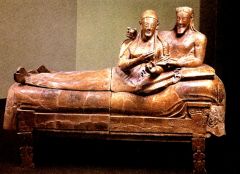
|
Sarcophagus of couple from Cerveteri, c. 520 BC (Etruscan); displays a husband and wife (which was hardly ever seen in Greek culture); men and women were seen as more equals in Etruscan culture; they do not look like they have bones, artist is not interested in the mechanics of the body as much as the greeks are; large scale clay piece (not something the Greeks ever did, allows them to do a lot more with the sculpture in terms of form); relatively smooth; already has a 3D feeling, shows movement ex: hand is reaching out (not something Greeks did until Hellenistic period)
|
|

|
Head of man (known as Brutus), c. 300 BC (Etruscan); don't really know who it is, but they are definitely trying to picture someone in particular; shows characteristics of the male: looks wise, fierce, etc..
|
|
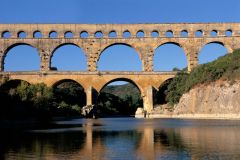
|
Pont du Gard, Nîmes, France, late 1st century BC (Roman); aquaducts; made of arches (made up of small blocks); they use a lot of engineering & percision; unique to Roman architecture, very advanced
|
|

|
Augustus of Primaporta, original from early 1st century AD (Roman); Augustus of Primaporta, original from early 1st century AD (Roman); his body is covered in symbolism (stories of the skies), cupid is located at his ankle (also is a form of symbolism); statue borrows from Doryphourus statue similar hair, contraposto, calm facial expressions; his face has individual characteristics however (you can tell he is Augusta); he wears clothes (unlike Greeks), his clothes are military; his gesture is different, he is reaching out and speaking to a crowd (almost like he is there connecting with them); he is trying to connect to his citizens, but still display his power over them; it gives a message (not everyone could read, so art was often used to transfer ideas)
|
|

|
Ara Pacis Augustae, Rome, 13-9 BC (Roman); Agustus wants peace after he eliminates everyone who killed his father; a period of peace follows for 200 years;this is an altar dedicated to this time of peace; it is not very big; decorated with realistic looking scenes of mythological stories
|
|
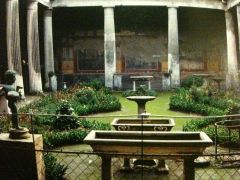
|
Peristyle, House of the Vettii, Pompeii, 62-79 AD (Roman); vacation house in Pompeii; typical high class home of Pompeii; still has wall paintings (due to preservation from volcano); also know what kind of plants grew there (thanks to volcano)
|
|
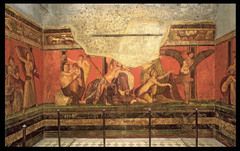
|
Initiation Rites, Villa of Mysteries, Pompeii, c. 60-50 BC (Roman); uses second style of Roman wall paintings; baseline is painted to look like marble; main middle part has lots of seductive people who are half clothed; they kind of come into your space (like Hellenistic temple of Zeus figures) also has a replica of Battle of Issoss, but its made of mosaics
|
|

|
Portrait of married couple, Pompeii, 1st century AD (Roman); women were at a much more equal level with men than in Greek culture (husband and wives are not often seen in Greek art); also shows the blending of ethnicity (rome is becoming a very mixed culture); shows individual characteristics, looks like actual people
|
|

|
Spoils from the Temple, Arch of Titus, Rome, c. 81 AD (Roman); scene of Romans destroying temple in Jeruselum and them running away with menorah
|
|

|
Flavian Amphitheater (Colosseum), Rome, 70-80 AD (Roman); large statue outside had originally been a statue of Nero: the structure is fragmented due to them using bricks from the Colosseum to build St. Peter's; it is made up of many arches; very technical and engineered; made out of a spinal column structure; made as an arena for combat area; sand at the bottom soaked up blood; had a retractable roof; doric column order at bottom, ionic in middle; corinthian order at tope; goes from strongest columns at bottom to the weakest at top
|
|

|
Young Flavian Woman, c. 90 AD (Roman); they are developing new technologies (new hair styles, curling irons); figure is very detailed and intricate
|
|

|
Romans crossing the Danube, from Column of Trajan, Rome, c. 113-116 AD (Roman); large tower that is carved as if it is a scroll wrapping around the tower (600 ft scroll); shows scenes of war; form of propaganda; broken down step by step; shown realistically like Hellenistic style; people are doing actions as if they do not know the camera is capturing them; River god is at bottom, he is bigger than everyone else so you can see him stand out over the others, beginning to see them start to lose the realism and art becomes more distorted in order to see clearity; they know how to be realistic but they begin to walk away from it in order to show what is important
|
|

|
Pantheon, Rome (interior), c. 118-128 AD (Roman); interior is very decorated; no columns or support in center so all weight pushes outwards onto walls (walls are 20 ft thick but hallowed out so they don't looks so bulky); roof steps out in order to help keep the roof from caving in; capitals on the porch are corintian with very intricate leaves; waffle pattern on the inside of roof cuts down on some spinal column system; has one window at top; use arches and concrete
|
|

|
Equestrian Statue of Marcus Aurelius, c. 176 AD (Roman); he is like a philosopher but he is not a man of peace, he has to fight; he builds a column commemorating his battles which is similar to the tower at the Forum (script wraps around it); shown as a barbarian and he is very rough and not shown as beatiful, very rough around the edges (not polished like classical art)
|
|

|
The Tetrarchs, c. 300 (Roman); no longer use any of the fancy greek details; now they are a lot more plain; moving away from realism and towards abstracion; no longer being shown as induviduals; repitiion of form; on hard purple tone (sign of royality)
|
|

|
Audience Hall, Trier, Germany, early 4th century (Roman); very large; tetarch style; almost like a big box; no more fancy Greek details; axiality, hierarchy; it is a church but it is bigger than most cathedrals
|
|

|
Arch of Constantine, Rome, 312-315 (Roman); Triumph arch; very traditional, except this one is kind of strange because it is celebrating Rome conquering itself in a Civil War; took parts off of old Golden Age styles; reliefs: not very realistic, but main man is in middle: realism isn't the important part, the important part is that he is the man that is to be focused on
|
|

|
Constantine the Great, Rome, 325-26 (Roman); ruthless emperor; kills anyone; brought christinaity to Romans after he had a dream of an angle showing him the cross, he then changed Rome into a Christian city; figure is huge (head is 8ft tall)
|
|

|
Priestess from Symmachi panel, c. 390-400 (Roman); shows that Classicism still exists in some cases; not used very much anymore during this time
|
|

|
Good Shepherd and Orants, Catacomb of Peter and Marcellinus, Rome, c. 300 (Early Christian);
|
|

|
The Good Shepherd, 2nd half of 3rd century (Early Christian); sort of classical (not as extreme as the Greeks though); have some use of contraposto; at this point in time, Jesus is always shown as a young beardless boy
|
|

|
Good Shepherd, from Mausoleum of Galla Placidia, Ravenna, 425 (Early Christian); mosaic shows God as the imperial leader; uses Classicism; makes 2D space to look 3D; realistic in style; Jesus is still shown as the small boy shepard; happens before golden style; eventually they take a step back and no longer portray things as realistically bc they are trying to show the holy world, doesn't look like our own, full of gold and glory
|
|

|
Hagia Sophia, Constantinople (Istanbul, Turkey), by Anthemius and Isodorus, 532-537 (Byzantine); built five years after riots, built very quickly; largest of its time; it is a palace church (mixing church and state); has a large central dome; it is very long and very wide; it is dark inside but still filled with golden light (gold ceilings); there used to be more light (more windows) but had to rennovate after an earthquake, but they did not add as many windows; gold globe hangs from ceiling "chain from heaven"; architecture is very similar to Roman architecture, similar to Pantheon; but the Pantheon looks much thicker and "beefy-ier"; Hagia Sophia has more windows, makes it look lighter and airy-er; support structures of Hagia Sophia are hidden (makes it look lighter); capitals (columns) are very different (no longer use Corinthian like Romans) instead they use a very abstract style (whole church is covered in this style); structure is similar to Roman basilicas; dome pushes out on the walls but still has light walls; the whole ceremony was based on mixing church and state
|
|

|
San Vitale (interior), Ravenna, Italy, c. 520-547 (Byzantine); made of brick; relatively light weight; marble on lower parts of inside with mosaics up top; built by Arians; Justinian didn't like that this was built by Arian Christinas, he thinks that Orthodox Christians are the right way of religion, so he tries to change that; he takes over and puts mosaics of himself & his wife in the church, very balanced compositions, (the rest about the mosaics is on a different flashcard)
|
|

|
Justinian and attendants, from San Vitale, Ravenna, Italy, c. 547 (Byzantine); inside the church of San Vitale; Justinian thinks that Arian Christians are wrong and that Orthodox Christians are the right way of religion, so he takes over the church (which was built by Arians) and he puts mosaics of himself inside; very balanced compositions; Justinian and his wife are directly in the center; men are in front of gold background, they also look like they are movingmore than the women (shows that they are the more powerful ones with more rights); Justinian is in the center however if you take out soliders on the side, you wont notice Justinian in the middle, now the two men are directly in the middle; above them is the ceiling with lamb of god (not realistically portrayed at all) tree in front of angels foot but angel's body is in front of the tree; doesn't work out in real life
|
|

|
Archangel Michael ivory, early 6th century (Byzantine); looks classical at first, but if you look closer there are flaws; he stands over 4 steps (no one can stand on that many steps); arm goes over door frame; style looks classical and body looks realistic, but his body does not fit into the space realistically
|
|

|
Virgin and Child, icon from Mount Sinai, Egypt, 2nd half of 6th century (Byzantine); it looks bad to worship icons of god, but still Romans like icons, so they continue to use them; you are supposed to use the images to worship through them (not to worship the image itself); people began worshipping the actual image, this is why icons become bad (for example, this image)
|
|

|
Monastery churches at Hosios Loukas, Greece, c. 1000 (Byzantine); similar to Hagia Sophia
|
|
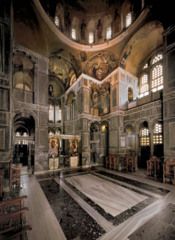
|
Katholikon, Hosios Loukas, Greece, early 11th century (Byantine)
|
|

|
Crucifixion, Church of the Dormition, Daphi, Greece, late 11th century (Byzantine); begining to see the pain and suffering of Christ; new style
|
|

|
David the Psalmist, from the Paris Psalter, 2nd half of 10th century (Byzantine); very Classical in style, style gets handed down (gold style also gets handed down) (these two styles go together)
|
|

|
Great Mosque of Kairowan, Tunisia, 836-75 (Islamic); hypostyle with minoret; located in Africa
|
|
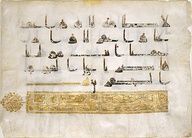
|
Kufic Page from the Qur’an, from Syria, 9th century (Islamic); from Egypt; has text that is surrounded by geometric shapes that span out in great detail
|
|

|
Mosque of Sultan Selim (exterior), by Sinan, Edirne, Turkey, 1568-75 (Islamic); originally tried to make Hagia Sophia into a mosque, but it didn't work out so they built this instead; unlike Hagia Sophia; structure is very big and bulky; has huge columns; lots of ornament and geometry
|
|

|
Apollo of Veii, c. 500 BC (Etruscan); he is a hallow clay piece; would have been an architecture piece; he is moving; he is from Archaic period; compare to Greek Kore; Etruscan statue is clothes (much more likely to see them clothed, unlike Greek statues which were nude); he is already moving (advanced for Archaid period); his hair is much more free and mobile than Greek art
|
|

|
Temple of Portunus, Rome, 2nd century BC (Roman); located in Rome; front porch, stairs only in front (similar to Etruscan temple); kinda dressed as a Greek temple though, made of stone, has ionic order
|
|

|
Basilica Ulpia, Rome, c. 112 AD (Roman); part of forum; large royal hall in center so emperor is raised above everyone else in order to make him seem more like a god, uses viewer interaction; basillica is made of columns, has flat roof made of coppering; building was destroyed so we don't really know if it was 2 or 3 stories; may have used a rigid triangle frame work called a truse; had lots of shops and bootiques along the outside (like a shopping mall)
|
|

|
Commodus as Hercules, c. 191-192 AD (Roman); still in classical style, idealized, classical hair, still pulling from classical calm facial expression; he is trying to represent himself as a powerful and fierce leader; he has his arm drawn back as if he is going to hit someone; wearing an animal around his body; he is being supported by Amazon figures; trying to represent himself as Hercules
|
|

|
Sarcophagus of Junius Bassus, Rome, 359 (Early Christian);
|
|

|
Virgin of Vladimir, perhaps from Constantinople, 11th-12th century (Byzantine)
|
|

|
Dome of the Rock, Jerusalem, 691 (Islamic); sacred shrine; they are supposed to make a pilgramage here once in their life time; it is said that Mahammad is buried here (probably not true); it is on a sacred rock; shrine is bult around Kabba; it looks similar to Byzantine art (due to the fact that the architects grew up as Byzantine and converted to Isalm, they brought their style with them); ornament on outside is very geometric and made of of shapes and designs (due to the fact that they are very strict about worshipping icons or figures)
|
|

|
Great Mosque of Cordoba, Spain, begun 785 (Islamic); place to pray/bow down; we see columns, capitals, arches (all from Roman architecture, keeps getting transformed into different styles for religions, 1st christianity, 2nd Islamic); uses double arches, halls of columns (like a forest); horse shoe arch (typical of Spanish early medieval architecture); combining & changing ideas (ex: linking horse shoe arches to make a chain); inside is a room made of arches that link and go around in a circle; quibla wall at back of mosque (where the sacred shrine is located)
|
|

|
Muquarnas Dome, from the Alhambra, Granada, Spain, 1354-91 (Islamic); extremly complex and ornament; gives sense of infinity bc they keep breaking pieces down; no figural ornament, only geometric or text; uses horse shoe arches; court of lions @ Alhambra; complex textures everywhere; use of many gardens and water features in order to make it seem like paradise (influences from Islam)
|
|

|
Tugra of Suleyman, 1550-1560 (Islamic); signature of sultan
|
|

|
Aulus Metellus (the Orator), c. 80 BC (Etruscan/Roman); gesturing out to the public; wearing the Roman toga
|
|
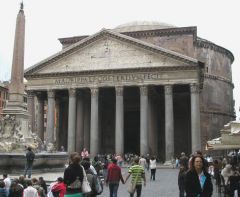
|
Pantheon, Rome (exterior), c. 118-128 AD (Roman); built under Trajans rule; once used as a Roman church; survived in great shape; has front porch with temple in back; interactive with viewer bc they have to walk in through the front; dedicated to all the gods; very plain on outside, most of the decoration is on the interior
|
|

|
Baths of Caracalla, Rome, c. 211-17 (Roman); started by Marcus Orielas, but finished by Caracalla; huge in size; as big as multiple football fields; half moon windows are called thermo windows; had hot and cold baths; people who built public baths bcame powerful (helped build their social status; bath houses were places with many things going on; people hung out here, had prostitutes, could escape city life; get water from aquaducts
|

